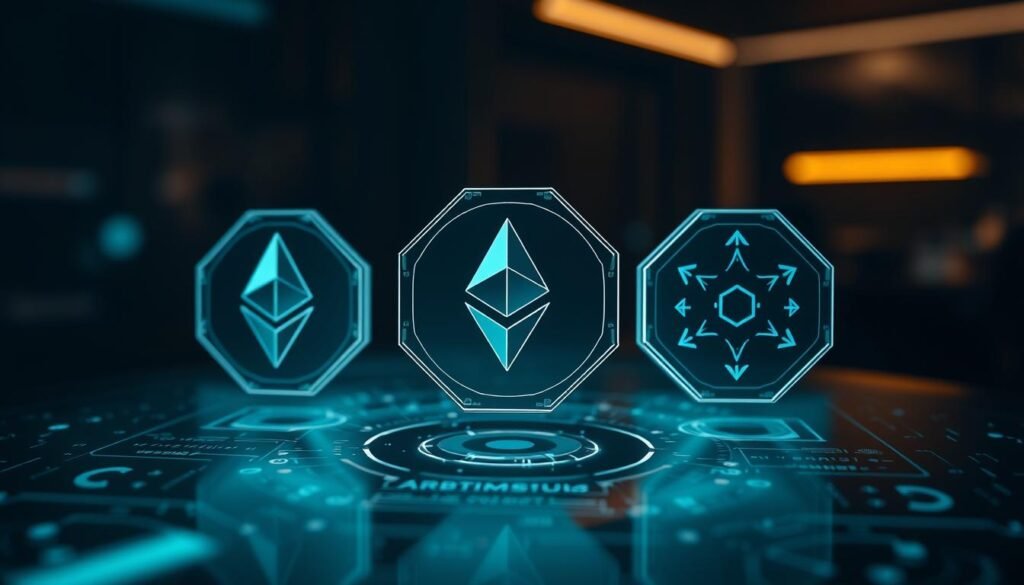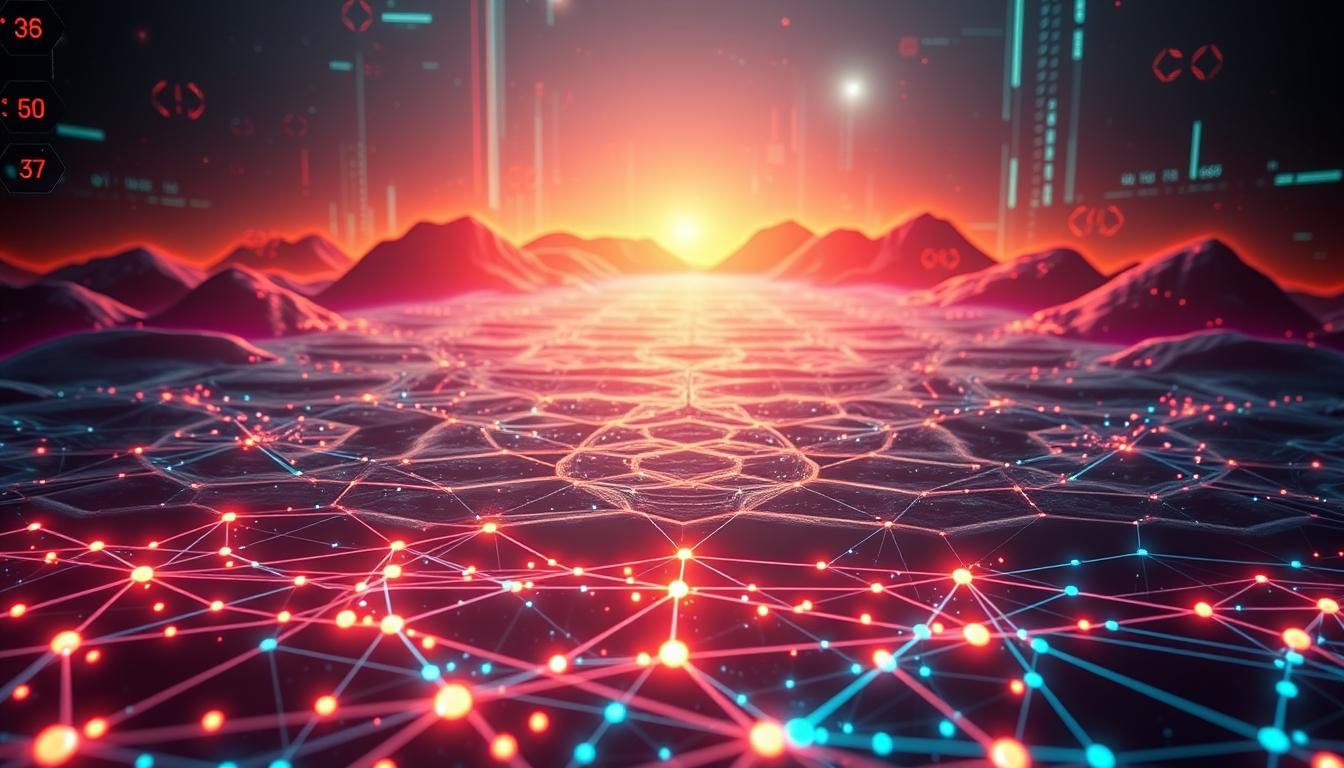The global blockchain market is forecasted to surpass $163 billion by 2027. This exponential growth highlights the crucial role of layer 3 blockchain technology. It enhances scalability and efficiency within blockchain ecosystems. As we explore the 7+ top layer 3 blockchains, you’ll see their significance in the blockchain landscape.
The evolution of blockchain technology is transforming industries and fostering innovation. Understanding the importance of these layer 3 solutions is key to grasping their impact on the decentralized world. In this article, we’ll delve into the leading layer 3 blockchain projects. We’ll discuss their significance and role in the blockchain ecosystem. Join us as we explore the captivating world of layer 3 blockchains and discover what the future holds.
To gain a deeper understanding of blockchain infrastructure and emerging technologies, explore this insightful piece on 1inch’s supported blockchains. Also, discover promising cryptocurrencies for 2025 with five cryptocurrencies to consider.
Key Takeaways
- Layer 3 blockchains enhance scalability and functionality.
- Multiple projects are leading innovations in this tech space.
- Industry growth is projected to continue, indicating strong interest.
- Understanding these blockchains is vital for future investments.
- Layer 3 solutions promote interoperability among various blockchains.
Understanding Layer 3 Blockchains
Layer 3 blockchains mark a significant advancement in blockchain technology, aiming to enhance functionality and scalability. They build upon existing infrastructures, introducing solutions for off-chain transactions and expanding dApp capabilities. These enhancements significantly boost transaction efficiency and speed, crucial for broader adoption.
What Are Layer 3 Blockchains?
Layer 3 blockchain technology involves additional components layered on top of Layer 2 solutions. These components aim to improve user experience and performance by reducing congestion and processing loads on the underlying blockchain. They enable the efficient handling of complex transactions and interactions within the network.
Importance of Layer 3 in Blockchain Ecosystems
The importance of Layer 3 blockchain development is its potential to create a more interconnected and robust ecosystem. It facilitates communication across various blockchain frameworks, enabling interoperability between networks. This interconnectedness enhances the utility of decentralized systems, opening doors to innovative applications and services. Moreover, as Layer 3 technologies evolve, they will be pivotal in shaping the future of digital transactions. For those considering investment in this space, understanding Layer 3 nuances is essential.
Key Features of Layer 3 Blockchains
Layer 3 blockchains introduce significant advancements, enhancing the functionality of blockchain ecosystems. They focus on scalability, interoperability, and privacy, aiming to overcome current blockchain challenges. These solutions are crucial for the future of blockchain technology.
Scalability
Scalability is a key feature of Layer 3 blockchains, significantly improving network performance. By adding layers on top of existing blockchains, they increase transaction throughput. This results in faster transaction confirmations, benefiting users and businesses alike.
Businesses prioritize this feature for its potential to enhance user engagement and streamline operations. It’s a critical factor for those adopting blockchain technology.
Interoperability
Interoperability stands out as a feature of Layer 3 blockchain solutions. It enables different blockchains to communicate seamlessly, promoting collaboration. This integration allows users to access a wider range of services, enhancing the utility of blockchain ecosystems.
This interoperability is essential for businesses aiming to expand their reach and optimize operations. It’s a key factor in maximizing business potential.
Enhanced Privacy
Enhanced privacy is a significant advantage of Layer 3 blockchains. Technologies like zero-knowledge proofs ensure secure, private transactions. This preserves sensitive information, allowing users to maintain transparency without compromising anonymity.
In today’s digital age, privacy and security concerns are paramount. Layer 3 blockchains address these needs, offering a secure environment for users.
Overview of Top Layer 3 Blockchains
The realm of top layer 3 blockchain protocols is in a state of constant evolution. This is due to significant technological breakthroughs and shifting market landscapes. The ranking of these protocols offers valuable insights into their potential influence. This section delves into the criteria for ranking and the emerging trends that are molding the future of layer 3 technologies.
Factors for Ranking
In evaluating a layer 3 blockchain comparison, several key elements are considered:
- Market Adoption: The extent of its application across various sectors and its acceptance by the community.
- Innovation: The degree to which a protocol introduces cutting-edge features, thereby enhancing its performance or security.
- User Base: The breadth and depth of the user community, crucial for network effects.
- Security: The presence of robust mechanisms to safeguard against vulnerabilities and attacks.
Trends in Layer 3 Blockchains
Monitoring trends offers a glimpse into the advancement of this technology. New alliances are being forged, broadening the scope of layer 3 solutions. Advancements in interoperability and the introduction of novel privacy solutions are ongoing. For those keen on a layer 3 blockchain comparison, staying abreast of these developments is essential. Further information can be accessed at this link, providing a deeper dive into current trends.
1. Polygon (MATIC)
Polygon, formerly known as Matic Network, has become a key player in the best layer 3 blockchain projects. It enhances Ethereum’s scalability and supports a wide range of layer 3 blockchain applications. Polygon’s versatility benefits sectors from gaming to decentralized finance (DeFi).
Overview and Use Cases
Polygon stands out as a versatile platform, addressing scalability issues through various layer 3 blockchain applications. It is home to NFT marketplaces, gaming apps, and transaction solutions. Polygon’s robust framework empowers developers, turning innovative ideas into reality. It boasts significant user engagement, proving its effectiveness in the blockchain world.
Key Features
Polygon’s strengths include its Polygon SDK and multi-chain framework. These features enable developers to create decentralized applications easily. Its architecture ensures scalability, leading to faster transactions at lower costs. This makes Polygon a top choice for those exploring the best layer 3 blockchain projects.
Community and Ecosystem
The Polygon community is instrumental in its growth. Collaborations with decentralized applications boost its ecosystem, driving innovation and support. Engaging with the community allows for knowledge sharing and application improvement. For more insights into blockchain, explore this article on Bitcoin pricing implications. Polygon’s thriving community solidifies its position as a leader in layer 3 solutions.
2. Arbitrum
Arbitrum stands out as a leading player in Layer 3 blockchain solutions, focusing on boosting efficiency for Ethereum users. It leverages optimistic rollup technology to significantly enhance scalability. This results in faster transactions and lower costs, attracting developers and businesses aiming for optimized blockchain operations.
Overview and Benefits
Arbitrum’s core advantages include a streamlined user experience and cutting-edge technology. It enables rapid transaction processing, ensuring a seamless interaction with decentralized applications. The use of optimistic rollups not only cuts costs but also preserves Ethereum’s security standards, making it a dependable choice for scalable solutions.
Ecosystem Partnerships
Arbitrum has established strategic partnerships across various sectors, including DeFi and NFTs. These alliances strengthen its ecosystem and showcase its versatility. Projects utilizing Arbitrum’s infrastructure benefit from increased user engagement and reduced transaction fees. As blockchain technology advances, Arbitrum’s partnerships continue to expand, reinforcing its market standing.
Unique Attributes
Arbitrum’s distinct features cater to the evolving needs of blockchain users. It integrates Layer 3 blockchain solutions, ensuring scalability without compromising security. This balance appeals to a broad user base, from developers to end consumers, positioning Arbitrum as a key player in the Ethereum network’s scaling efforts. Companies seeking to enhance their blockchain transaction efficiency can draw inspiration from Arbitrum’s cost-saving and agile models. For more insights on optimizing blockchain operations, refer to our detailed guide here.
3. Optimism

Optimism emerges as a frontrunner in the realm of Top layer 3 blockchain protocols, leveraging optimistic rollups to revolutionize Ethereum transaction scalability. This pioneering technology addresses critical blockchain challenges, offering a scalable solution. It enhances throughput and reduces fees, essential for broad acceptance.
Scaling Solutions
Optimism’s scaling solutions aim to optimize transaction processing. Through optimistic rollups, it facilitates quicker transaction speeds, backed by Ethereum mainnet security. These developments promise to alleviate Ethereum network congestion, opening up new avenues for decentralized applications.
Market Adoption
Optimism’s market adoption has seen a notable surge. As DeFi grows, more dApps are integrating with Optimism, driven by its performance benefits. Companies increasingly opt for Optimism, reflecting growing trust in its scalability solutions. This trend highlights the technology’s ability to address real-world issues and integrate smoothly into the evolving blockchain landscape.
Future Prospects
The future for Optimism looks promising. The team is committed to enhancing functionality and bolstering developer support through regular updates. The roadmap outlines further innovations, including interoperability enhancements, solidifying Optimism’s role in the community. Ongoing Layer 3 blockchain development efforts signal transformative shifts, poised to redefine user experiences and application capabilities.
4. zkSync
zkSync revolutionizes blockchain technology with its pioneering zero-knowledge rollup system. This innovation prioritizes privacy and scalability, ensuring secure transactions for users. As a leading layer 3 blockchain project, zkSync paves the way for superior performance and user experience across diverse applications.
Zero-Knowledge Technology
At the heart of zkSync’s functionality is its zero-knowledge technology. This technology validates transactions without exposing sensitive user data. Users can securely interact with layer 3 blockchain applications while maintaining their data’s privacy. This advancement significantly boosts security, making transactions smoother without compromising personal information’s integrity.
Applications and Use Cases
zkSync’s capabilities have made it a preferred choice for several sectors, especially in decentralized finance (DeFi) and non-fungible tokens (NFTs). Notable applications include:
- Enabling fast, low-cost transactions in DeFi platforms
- Improving NFT trading efficiency by reducing gas fees
- Allowing seamless integration with existing Ethereum-based applications
As zkSync expands its ecosystem, it showcases the potential of top layer 3 blockchain projects to transform user interactions in the blockchain world. Its ability to enhance transaction efficiency and security represents a significant milestone in blockchain technology’s evolution.
5. StarkWare
StarkWare is at the forefront of Layer 3 blockchain scalability innovation, leveraging zero-knowledge proofs. This cutting-edge technology facilitates rapid transactions, thereby boosting performance for both users and developers. Its commitment to pioneering solutions enhances efficiency, setting it apart from conventional approaches.
Community involvement is pivotal for StarkWare’s advancement. Feedback from users shapes ongoing enhancements, ensuring the platform evolves to meet the needs of its community. This dynamic interaction cultivates a thriving ecosystem, enabling users to actively participate in discussions on Layer 3 blockchain solutions.
StarkWare continually refines its offerings through surveys and analyses of industry feedback. For a comprehensive look into StarkWare’s vibrant community and culture, delve into the full report on their developmental strategies here.
6. Ronin
Ronin is revolutionizing the gaming industry with its Layer 3 solutions tailored for gaming. It stands out as a premier project, achieving notable success by integrating with renowned games. This integration showcases the potential of blockchain technology in interactive entertainment.
Focus on Gaming
This layer is dedicated to improving the gaming experience. It empowers developers to create decentralized applications with ease. Ronin’s unique scaling features enable lower fees and quicker transactions, essential for high-traffic gaming environments.
The platform’s design caters to both developers and players, ensuring a smooth interaction. This enhances user engagement, making it a standout in the gaming sector.
Success Stories
Ronin’s impact in gaming is evident through its success stories, especially with Axie Infinity and other hit games. These titles have leveraged Ronin’s capabilities, leading to increased transaction volumes and better user interactions. Developers praise Ronin for its efficiency and scalability, positioning it as a key player in layer 3 blockchain discussions.
7. Avalanche
Avalanche emerges as a pivotal player in Layer 3 blockchain development, distinguished by its advanced features and capabilities. It is engineered to serve both developers and end-users, offering high throughput and swift transaction processing. Its consensus mechanism is a cornerstone, facilitating rapid transactions and solidifying Avalanche’s position among the premier layer 3 blockchain protocols.
Features and Capabilities
Avalanche boasts several critical features that elevate its functionality:
- Scalability: It can process thousands of transactions per second.
- Flexibility: It enables the creation of bespoke blockchains for diverse applications.
- Low Fees: Transaction costs are minimized, fostering widespread adoption among users and developers.
Growing Ecosystem
Avalanche’s ecosystem is burgeoning, with a plethora of projects in DeFi and NFT sectors. This expansion underscores a commitment to nurturing innovative projects that harness its capabilities. As developers increasingly see the potential in Avalanche, market trends suggest a burgeoning interest in its functionalities. The platform’s unwavering support for developers cements its ambition to lead among the top layer 3 blockchain protocols.
Comparison of Layer 3 Blockchains
Exploring Layer 3 blockchains reveals the importance of performance, scalability, and cost structures. A thorough comparison aids developers and users in selecting the most suitable solutions. This analysis focuses on scalability and cost-efficiency metrics, drawing from industry reports and expert opinions. It showcases how each platform excels in these areas.
Scalability and Performance
Layer 3 blockchains vary in scalability and performance. Key factors include:
- Transaction Speed: Leading Layer 3 solutions boast impressive transaction speeds, making them suitable for high-volume applications.
- Throughput Capabilities: The ability to process multiple transactions at once is vital for scalability. Polygon and Arbitrum stand out in this regard.
- Network Resilience: Platforms that maintain performance under varying loads are crucial. Innovative technologies often lead to better reliability.
Cost-Efficiency
The financial aspect of Layer 3 blockchain scalability is significant. Key factors include:
- Transaction Fees: Reducing fees while increasing throughput is crucial for user expenses.
- Infrastructure Costs: Some Layer 3 solutions have lower infrastructure costs, promoting wider adoption.
- Resource Allocation: Efficient resource use allows some platforms to reduce costs without compromising performance.
Future of Layer 3 Blockchains

The realm of Layer 3 blockchain technology is poised for transformative shifts, propelled by groundbreaking innovations and the imperative for enhanced efficiency. As experts delve into this field, a plethora of emerging developments is anticipated. These could fundamentally alter our perception of interoperability, privacy, and scalability within the blockchain sphere.
Potential Developments
Anticipated advancements in Layer 3 blockchain solutions promise to elevate user experiences and introduce novel functionalities. Key areas of concentration include:
- Advanced Interoperability: Enhanced compatibility among blockchain networks will enable smoother transactions and the sharing of resources.
- Regulatory Adaptability: As regulatory frameworks evolve to address blockchain’s challenges, Layer 3 technologies will be crucial in crafting compliant systems.
- Improved Privacy Measures: New innovations may grant users greater control over their data, thereby enhancing transaction confidentiality.
Impact on the Blockchain Landscape
Layer 3 blockchain technology is poised to transform the conventional business paradigm by integrating blockchain across diverse sectors. The advent of advanced Layer 3 solutions could revolutionize industries such as finance, healthcare, and logistics. They promise to:
- Enhance operational efficiency through the automation of smart contracts.
- Decrease transaction and payment-related costs.
- Open up new avenues for decentralized finance applications and beyond.
Conclusion: Why Layer 3 Matters for the Future of Blockchain
Layer 3 blockchain technology is pivotal in shaping the blockchain industry’s future. It enhances scalability, security, and interoperability, addressing the growing needs of digital transactions and applications. Our 7+ top list of layer 3 blockchains showcases key players leading this innovation, each contributing uniquely to the ecosystem.
The versatility of the best layer 3 blockchain projects is remarkable. Platforms like Polygon and zkSync demonstrate the effectiveness of layer 3 solutions in solving real-world challenges. They streamline processes and enhance user experiences, offering exciting opportunities for developers and businesses.
The evolving nature of Layer 3 blockchains marks a significant moment for technology enthusiasts and professionals. As we move toward a more interconnected digital space, engaging with these innovations is crucial. The potential for growth and creativity in this sector underscores the importance of staying informed and involved for those interested in blockchain technology’s future.
